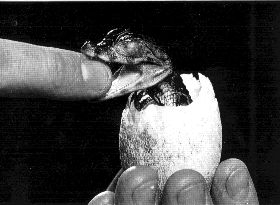Groundhog Day and Lowcountry Alligators
by Walt Rhodes - Alligator Complaint Numbers

Growing up on the Eastern Shore of Maryland afforded me the opportunity to see the distinct changes in nature's seasons. Each season lasted only a few months, with summer hot and steamy and fall characterized by cool nights and warm, colorful days. Winter was usually cold and snowy, and a steady south wind in late March ushered in spring and its many blossoms. Of particular interest were the winter months, the time when most folks fought off "cabin fever" and thought of the resurrection that spring brings. One of the barometers that could signal spring's wakeup was Groundhog Day.
Groundhog Day is a sacred time for people from snowbound cultures. The outcome of the day will provide the subliminal message for the ensuing weeks - either six more weeks of winter or an early spring. To a 12-year-old, I always wanted the six more weeks of winter because it potentially meant one more "snow day," a vacation from school. To determine the meteorological timing of the seasons, a veteran groundhog named "Punxsutawney Phil" emerged from his burrow and his shadow, or lack thereof, decided the outcome. If he sees his shadow, more winter; no shadow and it's an early spring.
Great ceremony surrounds the event. The town of Punxsutawney, Pennsylvania, is descended upon by hordes of media set to cover the event. Men dressed in top hats and coats with long tails announce, usually in the wee hours of the morning, the findings to the crowd. However, to folks in the Lowcountry, Groundhog Day generally occurs without much circumstance. The reasons I suppose are that most people of the coast don't have an affinity to groundhogs because sightings of the furry, underground excavator are as rare as seeing the Lizardman, and because the area is blessed with mild winters. Nonetheless, the Lowcountry still does have a winter and is in need of "a sign" to signal that spring is on its way.
One thing we are blessed with in the Lowcountry (hence the name) is water. From this we gain our identity - Santee-Cooper largemouths and catfish, McClellanville shrimp and miles of beaches. But from the water and the resulting swamps, we also acquire our ambassador of spring, the American alligator.

Being a cold-blooded animal, the gator's body temperature reflects the environment in which he inhabits. So when it's cold, he's cold and vice versa. Since the late days of November, our ambassador has been forced into a lethargic mode; however, the increasing amounts of daylight since the shortest day of the year (December 23rd) have sluggishly started nature towards spring. The alligator, with daily routine, is monitoring the lengthening days for warmth. On occasion, temperate days in January may tempt the gator to bask in the soothing rays, a chance to escape the 50-degree water. This is usually a short-lived event, ended by a cold front from the north.
Such a sighting of alligators generally prompts calls to the Department of Natural Resources about a "nuisance gator" that has appeared. But don't fear, alligators need to maintain a body temperature of 72 degrees or more before they can begin feeding, a reading that a gator can only dream about this time of year and won't reach until mid- to late-April. Occasionally, a few alligators will start to feed in March, but it's rare.
Although a cold blast will chase the gator back into hiding, which can be into a den or merely lounging on the bottom of the swamp, the alligator will still carry out a daily inspection for the sun's warmth. By February, the warm air seems to stream in from the south more than cold air settles down from the north, leading to a moderation of temperatures. This change triggers a metamorphism within the gator's frame. The juices that have lain idle all winter begin to flow, slowly reaching speeds that will propel the gator, whether ready or not, into the ritual of springtime procreation.
Content with changes happening within, the alligator must lie on the bank and wait, like the rest of us, for the yellow jasmine to bloom. But the alligator's daily presence now has signaled the end of winter. Keep your eyes peeled for the Lowcountry's own symbol of spring.
Walt Rhodes previously served as the Alligator Project Supervisor for South Carolina Department of Natural Resources.
